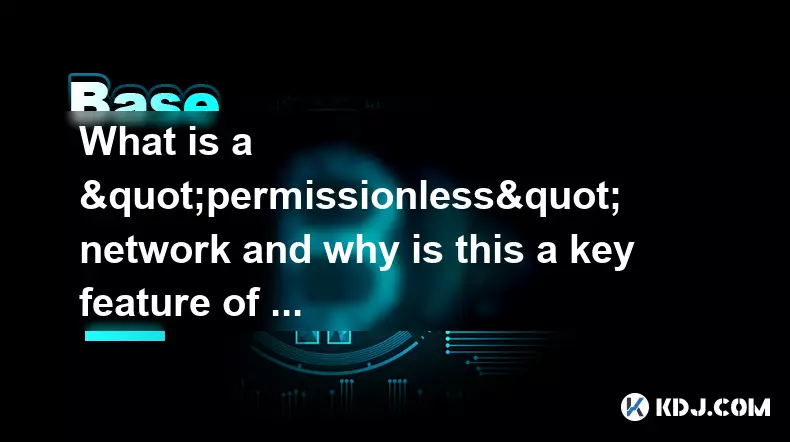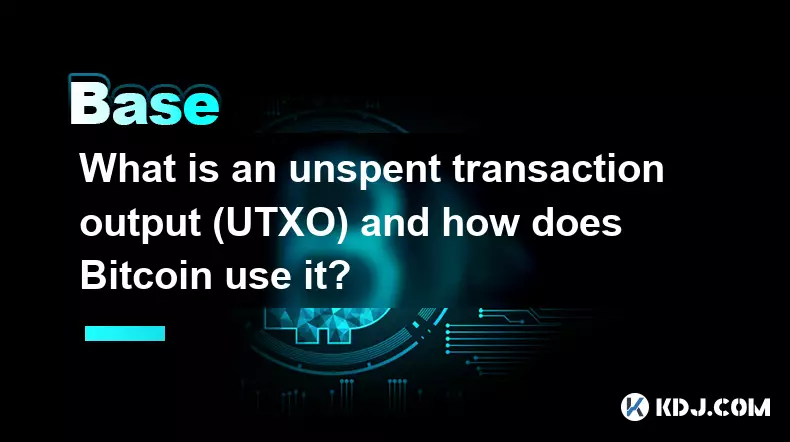-
 bitcoin
bitcoin $95122.959084 USD
-0.06% -
 ethereum
ethereum $3142.532402 USD
-0.28% -
 tether
tether $0.999439 USD
0.01% -
 xrp
xrp $2.209207 USD
-2.80% -
 bnb
bnb $925.395975 USD
0.07% -
 solana
solana $138.662599 USD
-1.73% -
 usd-coin
usd-coin $0.999753 USD
-0.02% -
 tron
tron $0.294100 USD
0.03% -
 dogecoin
dogecoin $0.161321 USD
0.35% -
 cardano
cardano $0.498672 USD
-1.53% -
 hyperliquid
hyperliquid $38.406659 USD
1.34% -
 zcash
zcash $679.663571 USD
5.44% -
 bitcoin-cash
bitcoin-cash $501.381807 USD
3.53% -
 chainlink
chainlink $13.975571 USD
-0.64% -
 unus-sed-leo
unus-sed-leo $9.166130 USD
-0.37%
What is a "permissionless" network and why is this a key feature of crypto?
A permissionless network allows open, trustless participation in cryptocurrency systems, where decentralization, transparency, and incentives ensure security and innovation.
Nov 09, 2025 at 08:40 am

What Defines a Permissionless Network in Cryptocurrency?
1. A permissionless network operates without centralized control, allowing anyone to participate without needing approval from a governing body. This means individuals can join the network, validate transactions, or mine blocks freely. The absence of gatekeepers ensures that no single entity holds dominance over operations.
2. In such systems, consensus mechanisms like Proof of Work or Proof of Stake enable participants to agree on the state of the blockchain. These protocols secure the network while maintaining decentralization. Nodes contribute computing power or stake assets to verify data integrity.
3. Open access fosters innovation by enabling developers to build decentralized applications (dApps) without seeking authorization. Smart contracts deploy seamlessly across the network, executing automatically when conditions are met. This environment encourages experimentation and rapid iteration.
4. Transparency is inherent in permissionless networks, as every transaction is recorded on a public ledger. Anyone can audit the blockchain, ensuring accountability and reducing opportunities for manipulation. This level of visibility strengthens trust among users who rely on cryptographic verification rather than institutional oversight.
Why Decentralized Access Matters in Crypto
1. Financial inclusion expands significantly under permissionless models. Individuals without access to traditional banking infrastructure can transact globally using only an internet connection. Wallets are created instantly, bypassing bureaucratic hurdles associated with conventional finance.
2. Censorship resistance emerges as a direct consequence of open participation. Transactions cannot be blocked or reversed by authorities due to the distributed nature of validation. This feature proves critical in regions where governments restrict capital movement or monitor financial activity.
3. Security improves because attackers must compromise a majority of nodes simultaneously to alter records—a feat that grows increasingly difficult as the network expands. The economic cost of such an attack often outweighs potential gains, deterring malicious actors.
4. Trust shifts from institutions to code. Users rely on cryptographic proofs and algorithmic rules instead of intermediaries. This transition reduces counterparty risk and minimizes reliance on third parties for transaction validation.
The Role of Incentives in Sustaining Permissionless Systems
1. Miners and validators receive rewards in the form of native tokens for securing the network. These incentives align individual interests with network health, encouraging honest behavior. Dishonest actions result in financial penalties or loss of staked assets.
2. Tokenomics play a crucial role in maintaining long-term viability. Well-designed emission schedules and reward structures prevent inflationary pressures while ensuring sufficient motivation for continued participation.
3. Community governance allows stakeholders to propose and vote on protocol upgrades. Changes are implemented based on collective agreement rather than unilateral decisions. This democratic process reinforces the ethos of decentralization.
4. The continuous influx of new participants strengthens network effects, making the system more resilient and valuable over time. As adoption increases, the cost of attacking the network rises proportionally, further solidifying its security model.
Common Challenges Faced by Permissionless Networks
1. Scalability remains a persistent issue, as increased transaction volume can lead to congestion and higher fees. Solutions like layer-2 protocols and sharding aim to address these limitations without compromising decentralization.
2. Regulatory scrutiny intensifies as permissionless networks gain prominence. Governments may view them as threats to monetary sovereignty or tools for illicit activities, prompting calls for restrictions or oversight.
3. User experience often lags behind centralized platforms. Managing private keys, understanding gas fees, and navigating wallet interfaces present barriers to mainstream adoption.
4. Despite these challenges, the core principle of unrestricted access continues to drive innovation and attract users disillusioned with traditional financial systems.
Frequently Asked Questions
How does a permissionless network differ from a permissioned one?A permissionless network allows anyone to join and participate without approval, whereas a permissioned network restricts access to verified entities. In permissioned systems, organizations control node operation and transaction validation, limiting openness but potentially increasing efficiency.
Can permissionless blockchains be regulated?Regulation targets user behavior and service providers rather than the protocol itself. Exchanges, wallets, and custodians become compliance points, but the underlying network remains autonomous. Enforcement focuses on on-ramps and off-ramps to traditional finance.
Are all cryptocurrencies built on permissionless networks?No. While Bitcoin and Ethereum operate on permissionless models, some enterprise-focused blockchains are permissioned. These are typically used within consortiums where trust exists among members, and control is shared among predefined participants.
What prevents bad actors from exploiting permissionless systems?Cryptoeconomic design discourages malicious activity through financial disincentives. Attackers risk losing staked funds or mining rewards if they act dishonestly. Additionally, the transparency of the ledger makes fraudulent transactions easily detectable by the community.
Disclaimer:info@kdj.com
The information provided is not trading advice. kdj.com does not assume any responsibility for any investments made based on the information provided in this article. Cryptocurrencies are highly volatile and it is highly recommended that you invest with caution after thorough research!
If you believe that the content used on this website infringes your copyright, please contact us immediately (info@kdj.com) and we will delete it promptly.
- LivLive ($LIVE) Dominates Crypto Presales in Q4 2025: The AR-Driven Revolution
- 2025-11-16 18:45:01
- Token of Thanks: Quilts, Real Estate, and Thanksgiving Tidbits
- 2025-11-16 18:25:01
- Bitcoin, Downgrades, and Wall Street: A Wild Ride
- 2025-11-16 16:45:01
- Crypto ETFs: Index Tracking and Market Access for the Savvy Investor
- 2025-11-16 10:05:01
- Wormable npm Packages and Token Stealers: A Deep Dive into Supply Chain Security
- 2025-11-16 10:00:01
- Penny Discontinuation: What It Means for Coin Values and Numismatists
- 2025-11-16 09:55:01
Related knowledge

What is the difference between a transparent and a shielded transaction?
Nov 10,2025 at 05:59pm
Understanding Transparent Transactions in Cryptocurrency1. Transparent transactions are the standard form of transaction on most public blockchains li...

What is a "crypto airdrop farmer" and what strategies do they use?
Nov 09,2025 at 03:39pm
What Is a Crypto Airdrop Farmer?1. A crypto airdrop farmer is an individual who actively participates in blockchain projects to qualify for free token...

What is an unspent transaction output (UTXO) and how does Bitcoin use it?
Nov 12,2025 at 01:40am
Understanding the Concept of Unspent Transaction Output (UTXO)1. An Unspent Transaction Output, commonly referred to as UTXO, is a fundamental compone...

What is a "governance attack" and how can a DAO be compromised?
Nov 14,2025 at 05:59am
Understanding Governance Attacks in Decentralized Autonomous Organizations1. A governance attack occurs when an individual or group gains disproportio...

How do you track a crypto portfolio across multiple wallets and chains?
Nov 12,2025 at 04:19pm
The Evolution of Decentralized Exchanges in the Crypto Ecosystem1. Decentralized exchanges (DEXs) have transformed how users trade digital assets by r...

What is a "rug pull" clause in a smart contract and how can you spot it?
Nov 14,2025 at 11:40pm
Understanding the Concept of a Rug Pull in Decentralized Finance1. A rug pull refers to a malicious act in the cryptocurrency space where developers a...

What is the difference between a transparent and a shielded transaction?
Nov 10,2025 at 05:59pm
Understanding Transparent Transactions in Cryptocurrency1. Transparent transactions are the standard form of transaction on most public blockchains li...

What is a "crypto airdrop farmer" and what strategies do they use?
Nov 09,2025 at 03:39pm
What Is a Crypto Airdrop Farmer?1. A crypto airdrop farmer is an individual who actively participates in blockchain projects to qualify for free token...

What is an unspent transaction output (UTXO) and how does Bitcoin use it?
Nov 12,2025 at 01:40am
Understanding the Concept of Unspent Transaction Output (UTXO)1. An Unspent Transaction Output, commonly referred to as UTXO, is a fundamental compone...

What is a "governance attack" and how can a DAO be compromised?
Nov 14,2025 at 05:59am
Understanding Governance Attacks in Decentralized Autonomous Organizations1. A governance attack occurs when an individual or group gains disproportio...

How do you track a crypto portfolio across multiple wallets and chains?
Nov 12,2025 at 04:19pm
The Evolution of Decentralized Exchanges in the Crypto Ecosystem1. Decentralized exchanges (DEXs) have transformed how users trade digital assets by r...

What is a "rug pull" clause in a smart contract and how can you spot it?
Nov 14,2025 at 11:40pm
Understanding the Concept of a Rug Pull in Decentralized Finance1. A rug pull refers to a malicious act in the cryptocurrency space where developers a...
See all articles










































































